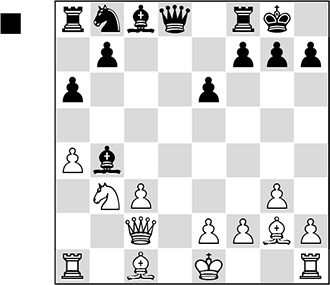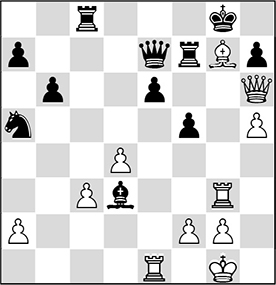Chapter 48
Intermediate moves
When in the middle of a variation, we suddenly play a deflecting move instead of the natural retreat or capture, we call this move an ‘intermediate’ move or zwischenzug. This usually happens on a different part of the board and with tempo, and brings about an important change to the position. Such possibilities often escape the players’ notice, and the ability to spot them can be improved by training one’s calculation of variations and gaining more experience.
291 *
Training position
Konstantin Sakaev

If we move the bishop to e7 or d6, White castles and then brings the rook to d1 with tempo. Later, the dark-squared bishop comes out to e3 or f4, exerting pressure on the black queenside. Consequently, there follows
12…♕c7!
White is forced to defend the pawn on c3, and bring his bishop to a passive square. At the same time, c7 is the best square for the black queen anyway, as she gets out of the attack along the d-file, exerts pressure on c3, and defends the pawn on b7, thereby freeing the light-squared bishop. After
13.♗d2 ♗e7 14.0-0 ♗d7!
followed by neutralising the white pressure along the long diagonal with …♗d7-c6, Black has a good game.
292 *
Alexander Beliavsky
Vladimir Malaniuk
Moscow ch-URS 1983 (12)

40…g3+!
This blow sows confusion in White’s ranks.
If Black takes the rook immediately with 40…♕xc1, then after 41.♘d8 g3+ 42.♔g2, White has set up a construction that allows him to give perpetual check. But now White resigned, since after 41.♔xg3 ♕xc1 42.♘d8 ♕g1+ 43.♔f4 ♕f2+, he continues to lose pieces with check.
293 *
Training position
Konstantin Sakaev

14.b4!
If we exchange on e5, then after 14.♗xe5 ♕xe5 15.♕xd2 0-0, the white e- and f-pawns are not sufficiently advanced, and he has no space advantage as a consequence. The reduced number of minor pieces remaining on the board also helps Black. The only plus White has is the d-file, which does not give him a real advantage, and a drawn outcome to the game looks highly likely.
14…♕c7 15.♗b3 ♗xb4
If 15…0-0 16.♕xd2 White’s advantage is great, whilst 15…♗xe3 16.fxe3 0-0 17.♕c5 leads to the loss of a piece.
16.axb4 ♕e7
Here too he cannot castle: 16…0-0 17.♕c3 ♖e8 18.♖a5 b5 19.♖xb5.
17.♖fd1 ♗e6 18.♗xe6 ♕xe6 19.♕c5 ♘g6 20.♗d6
Black has been unable to castle, and White can develop an attack both with pieces and with the e- and f-pawns.
294 *
Jean-Pierre Le Roux
2551
Konstantin Landa
2646
France tt 2012 (10)

13…c3!
In this case, the zwischenzug helps Black equalise.
A) 13…cxd5?! 14.♗xg7 ♔xg7 15.bxc4 ;
;
B) 13…♕d6?! 14.♗xg7 ♔xg7 15.bxc4 .
.
14.♗xc3 ♗xc3 15.♕xc3 cxd5
Black even temporarily wins a pawn.
16.♕c7 ♘d7 17.♗xd5 ♕xd5 18.♖ad1 ♕e6 19.♖xd7
Draw, because the variation 19…♕xe2 20.♖xe7 ♕xa2 21.♕xb7 ♖ab8 22.♕xa7 ♕xa7 23.♖xa7 ♖xb3, leads to a complete elimination of the fighting forces.
295 *
Konstantin Landa
2640
Alexander Poluliakhov
2511
Sochi 2012 (6)

20…♘d2?
The best continuation was 20…♕c8!, when White retains a small, but insignificant advantage.
21.♕xe6+ ♔h8 22.♖d1
Equally possible was 22.♖c1, exploiting the weakness of the back rank. 22…♗xg2 23.♔xg2 ♕xd4? 24.♖c8+–.

22…♖e8
After Black’s original intention 22…♕xd4?, there follows 23.e3!, the zwischenzug: 23…♕d3 24.♗xb7+–.
23.♕g4 ♗c8
23…♗xg2 24.♖xd2 ♗c6 25.f3! does not give Black many chances of surviving.
24.♕h5! g6 25.♕h4
1-0
296 **
Mateusz Bartel
2627
Pentala Harikrishna
2672
Germany Bundesliga 2011/12 (12)

White is to move, and Black has a knight under attack.
17.♖d1!
It turns out that we can first attack the queen, creating in the process the deadly threat 18.♕xc4+.
In the game, there followed 17.♕xf5 ♕d5 18.♕f3 ♕xf3 19.♘xf3 ♗f6, with Black having sufficient compensation for the pawn.
After
17…♗d5 18.♕xf5
thanks to the pin on the bishop, the c4-pawn is lost as well. White is winning.
297 **
Evgeny Bareev
2709
Joel Lautier
2658
Aix-les-Bains 2001 (4)

If we now simply take the bishop, then White’s advantage in the opposite-coloured bishops position will be minimal. Instead, White sees a tactical motif, connected with the unstable position of the black rook and the insufficiently protected black king on h8.
23.♘f6! ♗xf6 24.♖xc7 ♗xh4 25.♖gxg7!
Even more precise than 25.♖xb7 g6.
25…♕e4+ 26.♔g1
Black resigned.
298 **
Boris Spassky
2610
Robert Hübner
2600
Solingen 1977 (2)

With his last move, Black exchanged the light-squared bishop on d3. Everything would be fine for him if White had to take back on d3, but there followed the zwischenzug
24.♕h6! ♖cc7?
Allowing a forcing finish.
Bad was 24…♕f8? 25.♗xg7 ♖xg7 26.♖xg7+ ♕xg7 27.♕xe6++–.
The most tenacious was 24…♕e7! 25.♗xg7

analysis diagram
25…f4! 26.♖g4 ♗f5 27.♗f6+ ♗xg4 28.♗xe7 ♖xe7, but here too, there follows 29.d5! (29.♕xf4 ♖g7!) 29…♖f8 30.f3 ♗f5 31.♕xf4+–.
25.♕xe6 ♗c4 26.♖xg7+ ♔f8 27.♗xc7 ♕xc7 28.♖xf7+ ♕xf7 29.♕d6+ ♔g8 30.♕d8+
1-0
299 **
Richard Teichmann
Jacques Mieses
Vienna 1903

We have a sharp position on the board. It seems as though Black is winning, but it is important to find the correct order of moves. Calculating straightforward variations does not yield the correct answer:
A) 28…♖e2? 29.♖xf3! ♕xf3 30.♕xe2 ♕xf4 31.♕xe6+=;
B) 28…♖d5+? 29.♔c1! (29.♔e1 ♕c2!) 29…♕xa2 30.♕a4∞;
C) After 28…♕e2+!?,

analysis diagram
Black still has to show his endgame technique: 29.♔c1 ♖e4 30.♕xe2 fxe2 31.♖e1 ♖xf4 32.♖xe2 ♔f7 33.♖d2 ♔e7 34.♖g2 ♔f6 35.♖d2 .
.
Instead, he decides the game with
28…b5!
0-1
Because of 29.♕xb5 ♕e2+ 30.♕xe2 fxe2+ 31.♔e1 exf1+♕ 32.♔xf1 ♖f5–+.
300 **
Vladimir Akopian
2655
Miguel Illescas Cordoba
2635
Ubeda 1997 (5)

The immediate knight sacrifice on g7 does not bring success, because the black queen can defend along the fifth rank. Therefore, White first drove the queen away:
20.♗c3!
And only after…
20…♕d8
landed the blow…
21.♘xg7! ♔xg7 22.♕g4+ ♔h8 23.♕f5 ♔g8

24.♖h6! ♔f8
24…b5 25.♕g5+ ♔f8 26.♖xh7+–.
25.♕g5! d5 26.♖xh7 ♗c5+ 27.♘xc5 ♘xh7 28.♕h6+ ♔e7 29.♕h4+ ♔f8 30.♕h6+ ♔e7 31.♕h4+ ♔f8 32.♕xh7 ♖e6 33.♘xe6+ fxe6 34.♕g7+ ♔e8 35.♗f6 ♕d6 36.♕g8+ ♔d7 37.♕xa8 ♕b6+ 38.♔f1 dxe4 39.♕f8
1-0
301 **
Nelson Gamboa
2410
Juan-Manuel Bellon Lopez
2445
Santa Clara 1999 (7)

Having achieved a large advantage against a weaker player, the grandmaster relaxed.
25…♘5b6?!
He could easily have found the variation 25…♖xg4 26.♕xg4 ♖f8 27.♕g3 (27.f3 ♘e3–+) 27…♖e8 28.♕f3 ♘7b6, with a mating attack.
26.♖xb6! ♖xg4!
Black notices in time the line 26…axb6 27.♖a1 ♕b5+ 28.♔c2+–, and luckily for him the game ends not with a banal oversight, but flares up anew.
27.♕xg4

27…♖f8!!
A brilliant zwischenzug.
27…axb6 28.♖a1 ♕b5+ 29.♔c2 ♖f8 30.♖a8+ ♔c7 31.♖xf8 ♘xf8 32.♕f4+ ♔d7 33.♕f7+!+–.
28.♕e2?
Other continuations lose:
A) 28.f4 axb6 29.♖a1 ♕b5+ 30.♔c2 ♔c7–+;
B) 28.f3 ♖e8! 29.f4 axb6 30.♖a1 ♕b5+–+;
C) 28.♖e1 is the most tenacious, but after 28…♖xf2+ 29.♖e2 ♖xe2+ 30.♕xe2 axb6 31.h5 c5 32.h6 cxd4 33.♕d2 ♕b5+ 34.♔c1 ♕h5 35.cxd4 ♘f6, Black should win.
28…♘xb6 29.♕e6+ ♔d8 30.♕d6+ ♘d7–+
Suddenly, Black has everything defended.
31.f3 ♖f5
Also good was 31…♖e8!.
32.♕a3 ♖b5+ 33.♔a2 ♕c2+ 34.♔a1 b6 35.♖c1 ♕d2
White resigned.
302 **
Jan Gustafsson
2633
Zahar Efimenko
2702
Halkidiki Ech tt 2011 (4)

The position has an unclear character. If Black manages to stabilise and strengthen his position, he will hardly be worse. White needs to play energetically.
24.♗xh6! ♘xe4 25.♕h5

25…♘f6??
The decisive mistake.
Black could maintain equality in the complications after 25…gxh6! 26.♗xe4 ♘d2!. There are many variations here, but there seems to be no advantage for White in any of them.
26.♖xf6! ♕xf6

27.♗h7+!
An extremely important zwischenzug, which wins for White.
It was not too late to step on a hidden mine with 27.♗g5? g6!. Here, it is Black who plays the zwischenzug, after which he is simply better.
27…♔f8 28.♗g5 ♖e5
28…♕e5 29.♗d3+–.
29.♗f5! g6 30.♕h4
Black must part with material.
30…♕xg5 31.♕xg5 ♗xf5 32.♕h4
Black resigned.
303 ***
Viktor Kortchnoi
2544
Francisco Vallejo Pons
2698
Gibraltar 2011 (10)

28…♖xb6?
The only move to maintain equality was the zwischenzug 28…e2!. A draw is achieved after 29.♖e1 (29.♖d7+?! ♕xd7! (not 29…♔f8? 30.bxc7 e1♕+ 31.♗f1 ♖e8 32.♖f4! ♗xf4 33.♕xf4 ♕e6 34.♖d8 ♔g7 35.c8♕ ♕xc8 36.♖xc8 ♖xc8 37.♗d3+–; 29…♘xd7 30.♕f7+ ♔d6 31.♕d5+ ♔e7 32.♕f7+=) 30.♕xe5+ ♔f8 31.♕xb8+ ♘e8 32.♗xe2 ♕xa4 33.b7 ♕b4 34.♗h5 ♖e6 35.♔h2 ♖e7 36.♗f3 ) 29…♖xb6 30.♖xe2 ♘d7 31.♖d2 (31.♕f7+ ♔d8 (31…♔d6 32.b4!!+–) 32.♖a8+ ♖b8 33.♖d2 ♗d4 34.♖e2 ♗e5=) 31…♗d4 32.♖e2+ ♗e5 33.♕f7+ ♔d8 34.♖a8+ ♖b8 35.♖d2 ♗d4 36.♖e2=. The two sides cannot avoid a repetition of moves.
) 29…♖xb6 30.♖xe2 ♘d7 31.♖d2 (31.♕f7+ ♔d8 (31…♔d6 32.b4!!+–) 32.♖a8+ ♖b8 33.♖d2 ♗d4 34.♖e2 ♗e5=) 31…♗d4 32.♖e2+ ♗e5 33.♕f7+ ♔d8 34.♖a8+ ♖b8 35.♖d2 ♗d4 36.♖e2=. The two sides cannot avoid a repetition of moves.

29.♖da1?
A gift of fate.
White misses the simple win 29.♖a7! ♕xa7 30.♕xe5+ ♔f8 31.♖d8+ ♔g7 32.♖g8+ ♔h6 33.♕f4+ ♔h5 34.♗e2++–.
29…♔f8 30.♗d5 e2 31.♕f2 ♗d4 32.♕xe2 ♘xd5 33.♖a8+ ♔g7 34.♕f3 ♔h6 35.♖1a7 ♕f4
White resigned.
Additional material
Geller-Spassky, Riga 1958
Dolmatov-Kuzmin, Kislovodsk 1982 – White’s 27th move
Hübner-Tal, Biel 1976 – Black’s 26th move
Kasparov-Karpov, Tilburg 1991 – White’s 15th move